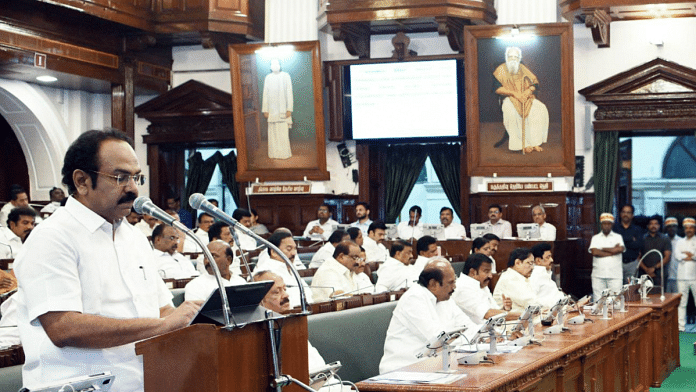Chennai: In his budget speech this week, Tamil Nadu Finance Minister Thangam Thennarasu made a surprise announcement — that the Dravida Munnetra Kazhagam (DMK) government was going to allocate Rs 2 crore towards the preservation of two languages, Badaga and Saurashtra.
Both Badagas and Saurasthrians represent unique ethnic groups in the state of Tamil Nadu. Badaga is a 2,300-year-old Dravidian language spoken by the Badaga people in the Nilgris and bears striking similarities to Kannada. On the other hand, Saurashtra is a language of the Indo-Aryan family spoken by the Gujarati Hindu Brahmin community that migrated to Tamil Nadu from southern Gujarat after the fall of Somnath Temple in the 11th Century.
The two groups together account for nearly 4 lakh speakers in the state.
“To document and preserve the Saurashtra and Badaga languages spoken in Tamil Nadu, along with the linguistic resources and phonetic forms of various tribes such as Todar, Kothar, Solagar, Kani, and Narikuravar from an ethnographical perspective, the Government of Tamil Nadu will allocate Rs 2 crore for the benefit of future generations,” Thennarasu said.
The announcement was met with mixed reactions. While Sourashtra Foundation, a Madurai-based social outfit representing Saurashtrians, welcomed the DMK government’s decision, the Badaga Desa Party, a social organisation presenting the group, appeared skeptical. BDP has been fighting for Scheduled Tribe status for the Badagas — while the group was listed as ST under the British, it lost that status after the 1951 Census.
According to B. Venugopal, a founding member of the BDP, the language is still categorised as a subset of Kannada. “The community is still not protected with an ST status. So, I don’t know how the government is going to preserve it,” he told ThePrint.
Also Read: Sengol puts focus on Tamil Nadu’s Adheenams. Wings clipped by Dravidian politics, now courted by BJP
Original inhabitants of the Nilgiris — who are the Badagas
Categorised as a “definitely endangered language” by UNESCO, Badaga is categorised as a dialect of Kannada and comes from the Tamil-Kannada branch of Dravidian languages.
According to the 2011 Census, Badaga has 1,33,550 speakers, predominantly in the Nilgiris, a hilly district located in the western region of the state that shares its borders with Kerala and Karnataka.
The 2011 Nigiris district census handbook classifies Badagas, along with other indigenous groups such as Todas, Kotas, Kurumbas, and Irulas, as the district’s “original inhabitants”.
The Tamil Nadu government, however, lists them as a “backward class” group found predominantly in the Gudalur, Coonoor, and Kotagiri regions of the district.
Badaga means northerner in Kannada. According to the World Culture Encyclopedia, “The name “Badaga” (northerner) was given to this group because they migrated from the plains of Mysore District, just to the north of the Nilgiri Hills, in the decades following the Muslim invasion that destroyed the great Hindu empire of Vijayanagar in AD 1565.”
According to the Endangered Language Archive — a digital repository of endangered languages — although Badaga is considered an offshoot of Kannada, “it developed independently after a group of Kannada speakers left Karnataka in the 16th century, and migrated south to the isolated Nilgiri mountains”.
Like several languages in India, Badaga doesn’t have a script.
On his blog ‘Badagas of the Blue Mountain’, D.R. Haldorai, a Badaga scholar from the Nilgiris, says the Badaga language finds extensive mention in the Tholkappiyam — the most ancient extant Tamil grammar text and the oldest extant long work of Tamil literature. The text calls Badaga a separate language spoken in a nation north of Tamil Nadu called ‘Vadagam [Badaga]’.
Venugopal said that the growing industrialisation of the Nilgiris has forced several Badagas to sell their land and migrate to metropolitan cities like Chennai.
Only giving it an ST status can prevent more urban migration, he said, adding that the group has been asking for ST status since 1971.
Royal silk weavers — who are the Saurasthrians
Unlike Badaga, Saurashtra is an Indo-Aryan language. Since the Saurashtrians migrated from Saurashtra, a region in the southwestern part of present-day Gujarat, their language is Gujarati but borrows heavily from not only Tamil but also languages like Marathi and Telugu.
The Saurashtrian community now mostly resides in the southern states of Tamil Nadu, Andhra Pradesh, and Karnataka. Their migration to the southern parts of the country is believed to be primarily a result of the desecration of the Somnath Temple, their religious centre, by Mahmud of Ghazni in 1024.
Many Saurashtrians are also believed to have come to Tamil Nadu in the 17th century as royal silk weavers to the Nayak kings. According to the 2011 Census, there are 2,47,702 Saurashtra speakers in Tamil Nadu — a majority of them in Madurai, Thanjavur, and Salem.
Although the language is categorised under Gujarati, the Saurashtra script also has visible similarities to the Tamil and Telugu scripts as well as Devanagari.
R.B.R.Ramasubramanian, president of the Madurai-based Sourashtra Foundation, urged the DMK government to appoint a Saurashtrian as the vice-president of the Tamil Nadu Minority Commission and the director of the Tamil Nadu Linguistic Minority Development Corporation.
“The language is still alive in the southern states of Karnataka, Tamil Nadu, and Andhra Pradesh,” he said. “The community is also actively involved in spreading it to the younger generation, not only by teaching it to them but also by translating major Tamil works such as (the ancient Tamil didactic text) Thirukkural.”
(Edited by Uttara Ramaswamy)
Also Read: Ramayan to Mahabharat, what ancient Hindu texts teach us about honouring tribals



